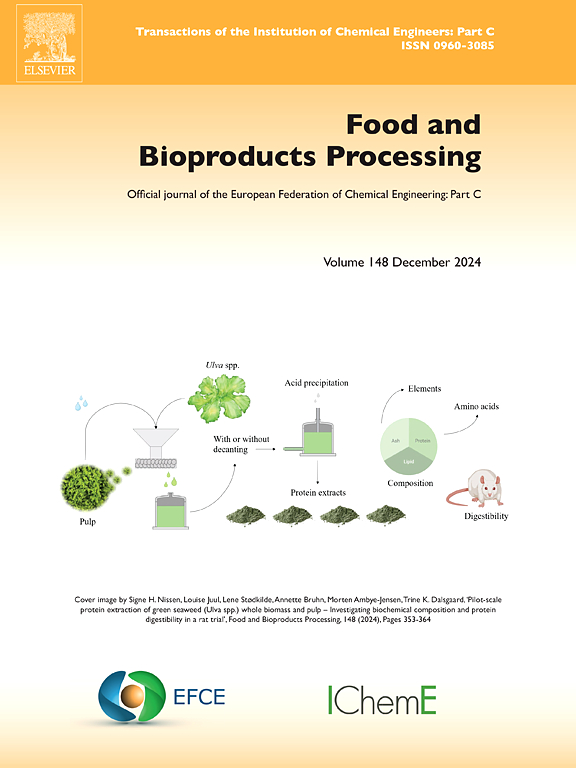利用一株原生拟植物乳酸杆菌M23发酵提高脐橙汁的功能成分和生物活性
IF 3.5
2区 农林科学
Q2 BIOTECHNOLOGY & APPLIED MICROBIOLOGY
引用次数: 0
摘要
乳酸菌发酵脐橙汁的研究很少。本研究发现,从脐橙中分离出的一种本地乳酸菌——拟植物乳杆菌M23,可以有效地发酵脐橙汁,生产出具有增强功能活性和感官品质的果汁。在整个7天的发酵过程中,发酵橙汁的活菌数始终保持在8.51 log CFU/mL以上。发酵后的橙汁中维生素C (VC)、总酚含量(TPC)、总黄酮含量(TFC)和橙皮苷含量分别比未发酵的橙汁最高提高了28.88倍、1.21倍、1.13倍和1.16倍。发酵后的果汁的抗氧化活性显著高于未发酵的果汁,分别提高了255 %和347 %(基于1,1-二苯基-2-吡啶肼(DPPH)和铁离子还原抗氧化能力(FRAP))。Pearson相关分析表明,这可能是由于VC和类黄酮含量的增加。此外,与未发酵的橙汁相比,发酵后的橙汁表现出更好的α-葡萄糖苷酶抑制、抗mrsa和抗糖基化活性。此外,发酵汁显著降低了Raw 264.7细胞中NO和ROS的水平,但对细胞活力没有负面影响。本研究结果可为开发营养健康的发酵脐橙汁产品提供参考,并可为其他水果利用本土菌株生产发酵饮料提供参考。本文章由计算机程序翻译,如有差异,请以英文原文为准。
Improving the functional components and biological activities of navel orange juice through fermentation with an autochthonous strain Lactiplantibacillus paraplantarum M23
The fermentation of navel orange juice with lactic acid bacteria (LAB) has rarely been investigated. In this study, an autochthonous LAB strain isolated from navel orange, Lactiplantibacillus paraplantarum M23, was found to effectively ferment navel orange juice, producing a juice with enhanced functional activities and organoleptic quality. The viable bacterial count in the fermented orange juice remained consistently above 8.51 log CFU/mL throughout the entire 7-day fermentation period. The content of vitamin C (VC), total phenolic content (TPC), total flavonoid content (TFC), and hesperidin in the fermented orange juice increased by a maximum of 28.88, 1.21, 1.13, and 1.16 times, respectively, compared to the unfermented orange juice. The fermented juice exhibited significantly higher antioxidant activity than the unfermented juice, with an increase of up to 255 % and 347 % based on 1,1-diphenyl-2-picrylhydrazyl (DPPH) and ferric ion reducing antioxidant power (FRAP) assays, respectively. This may be attributed to the increase in VC and flavonoids, as demonstrated by Pearson's correlation analysis. Additionally, the fermented orange juice demonstrated improved α-glucosidase inhibition, anti-MRSA, and anti-glycation activities compared to the unfermented juice. Furthermore, the fermented juice notably reduced the levels of NO and ROS in Raw 264.7 cells without any negative impact on cell viability. The findings of this study may help in the development of nutritious and healthy fermented navel orange juice products, and serve as a reference for the production of fermented beverages from other fruits using autochthonous strains.
求助全文
通过发布文献求助,成功后即可免费获取论文全文。
去求助
来源期刊

Food and Bioproducts Processing
工程技术-工程:化工
CiteScore
9.70
自引率
4.30%
发文量
115
审稿时长
24 days
期刊介绍:
Official Journal of the European Federation of Chemical Engineering:
Part C
FBP aims to be the principal international journal for publication of high quality, original papers in the branches of engineering and science dedicated to the safe processing of biological products. It is the only journal to exploit the synergy between biotechnology, bioprocessing and food engineering.
Papers showing how research results can be used in engineering design, and accounts of experimental or theoretical research work bringing new perspectives to established principles, highlighting unsolved problems or indicating directions for future research, are particularly welcome. Contributions that deal with new developments in equipment or processes and that can be given quantitative expression are encouraged. The journal is especially interested in papers that extend the boundaries of food and bioproducts processing.
The journal has a strong emphasis on the interface between engineering and food or bioproducts. Papers that are not likely to be published are those:
• Primarily concerned with food formulation
• That use experimental design techniques to obtain response surfaces but gain little insight from them
• That are empirical and ignore established mechanistic models, e.g., empirical drying curves
• That are primarily concerned about sensory evaluation and colour
• Concern the extraction, encapsulation and/or antioxidant activity of a specific biological material without providing insight that could be applied to a similar but different material,
• Containing only chemical analyses of biological materials.
 求助内容:
求助内容: 应助结果提醒方式:
应助结果提醒方式:


